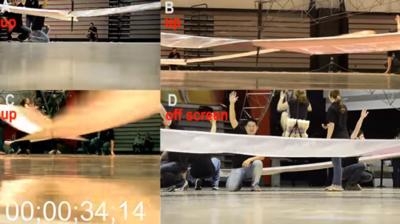Wed, May 11, 2016
The Gamera Project Achieved The Milestone In 2011
On May 12, 2011, biology student and female pilot Judith Wexler flew the human-powered helicopter “Gamera I” for 4.2 seconds in College Park, MD (USA), thus setting the first ever FAI world record in this type of aircraft.

The “Gamera Project” was introduced to try and achieve the dream of human-powered hovering flight. No less than fifty graduate and undergraduate students from the Alfred Gessow Rotorcraft Center of the University of Maryland’s Department of Aerospace Engineering participated in the design and construction of Gamera I. It was made of several lightweight composites and foam, the total weight of this quadrotor helicopter was just about 210 pounds including the pilot. It was built of four trusses, each with a rotor. Both hand and foot pedalling drive the rotors for improved performance. Four cameras were positioned to film the attempt, as the aircraft was so large.
For such records three factors are essential: design, weight, and power. In order to increase the altitude and time in the air, reducing the weight of the aircraft, increasing the efficiency of the rotor design and finding a pilot of just the right size and strength are critical.
Since May 2011, not many records have been set in this very special category. Two months after the first record, Judith managed to supersede her own record with “Gamera II”, a refinement of the “Gamera I”. The current record which was achieved only two years later, is held by Justin Mauch who was airborne for 1 minute and 37.5 seconds. The enormous increase of flight duration between the first and the most recent record shows just how significant and fast the development of human-powered flight has become.
The rules and regulations of Human Powered aircraft are defined in the FAI Sporting Code as an aerodyne that takes off and remains airborne only by direct human muscular energy. It must not use any system of static support such as gas or hot air nor may it carry any kind of apparatus that could receive energy during flight although such equipment may be used to store muscular energy after take-off.
(Source: FAI news release. Image from FAI video)
More News
Aero Linx: JAARS Nearly 1.5 billion people, using more than 5,500 languages, do not have a full Bible in their first language. Many of these people live in the most remote parts of>[...]
'Airplane Bounced Twice On The Grass Runway, Resulting In The Nose Wheel Separating From The Airplane...' Analysis: The pilot reported, “upon touchdown, the plane jumped back>[...]
"Burt is best known to the public for his historic designs of SpaceShipOne, Voyager, and GlobalFlyer, but for EAA members and aviation aficionados, his unique concepts began more t>[...]
"Polaris Dawn, the first of the program’s three human spaceflight missions, is targeted to launch to orbit no earlier than summer 2024. During the five-day mission, the crew >[...]
There Are SO Many Ways To Get YOUR Aero-News! It’s been a while since we have reminded everyone about all the ways we offer your daily dose of aviation news on-the-go...so he>[...]
 ANN's Daily Aero-Linx (05.04.24)
ANN's Daily Aero-Linx (05.04.24) NTSB Final Report: Quest Aircraft Co Inc Kodiak 100
NTSB Final Report: Quest Aircraft Co Inc Kodiak 100 Aero-News: Quote of the Day (05.04.24)
Aero-News: Quote of the Day (05.04.24) Aero-News: Quote of the Day (05.05.24)
Aero-News: Quote of the Day (05.05.24) Read/Watch/Listen... ANN Does It All
Read/Watch/Listen... ANN Does It All



